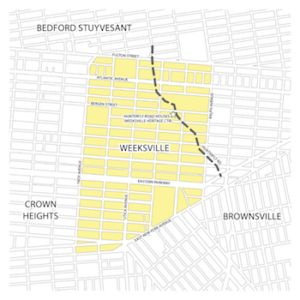
Fire House on Ralph Ave.
*On this date from 1838, the Registry celebrates the Weeksville section of Brooklyn, New York. This is a community that was built by blacks, for blacks, before American emancipation.
In 1838, only eleven years after slavery ended in New York State, a free Black man James Weeks purchased a modest plot of land from Henry C. Thompson, another free Black man. That land in what is now Central Brooklyn became Weeksville, a thriving, self-sufficient Black community. Weeksville quickly became a haven for southern Blacks fleeing slavery and free northern Blacks fleeing racial hatred and violence, including the deadly Civil War draft riots in lower Manhattan.
A suburban enclave on the outskirts of Brooklyn, by 1850 and Weeksville became the second largest known independent Black community before the American Civil War. Weeksville was also the only Black community whose residents were distinctive for their urban rather than rural occupations and the only one that merged into a neighborhood of a major American city after the war. Additionally, 19th-century Weeksville had a higher rate of Black property ownership than 15 other U.S. cities and more job opportunities than ten other northern cities. By the 1860s, Weeksville had its schools, churches, an orphanage, an old age home, a variety of Black-owned businesses, and one of the country’s first Black newspapers, Freedman’s Torchlight. Almost 500 families headed by ministers, doctors, teachers, tradesmen, and other self-reliant citizens lived in Weeksville by the 1900s.
Its citizens included Alfred Cornish, a member of the 54th Regiment whose story was told in the film Glory; Dr. Susan Smith McKinney-Steward, the first female African American physician in New York State and the third in the nation; Moses P. Cobb, the first African American policeman in Brooklyn’s Ninth Ward, and Junius C. Morel, a well-known educator, journalist, and activist. Weeksville covered seven blocks and was a model of African American entrepreneurial success, political freedom, and intellectual creativity. Its residents participated in every major national effort against slavery and for equal rights for free people of color, including the black convention movement, voting rights campaigns, the Underground Railroad, the Civil War, resistance to the Draft Riots in New York City; Freedman’s schools and African nationalism. According to one historian, Public School 83 in Weeksville became the first public school in the nation to integrate its teaching staff fully."
The community still existed through the 1930s, but by the mid-1950s, Weeksville was forgotten, with many of its structures and institutions replaced by new roads and buildings. In the 1960s, Weeksville was a historical footnote that historian James Hurley and pilot Joseph Haynes set out to research from the air. The Weeksville Society carries on the tradition of this beautiful community year-round. Mainly through the tireless work of the late Joan Maynard, their Oasis newsletter is packed with valuable information from their Black History Month celebration, summer workshops, and much more.
Image: "King of the Hill" Fire House at 423 Ralph Avenue, Brooklyn NYC